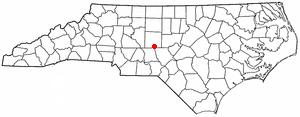Seagrove, North Carolina
|
|
Seagrove is a town located in Randolph County, North Carolina. Seagrove is notable for its many potteries, and it is sometimes referred to as the "pottery capital of North Carolina", or even of the world. In this usage, the name Seagrove not only refers to the town proper, but includes several other communities that are part of the pottery tradition. As of the 2000 census, the town had a total population of 246.
Nearly 100 potteries are located in Seagrove and the neighboring towns of Star, Whynot, Erect, Westmoore, and Robbins. Seagrove is also home to the North Carolina Pottery Center, which was established on November 7, 1998 and has since received visitors from all 50 states and at least 20 foreign countries.
| Contents |
History
Seagrove was named for Edwin G. Seagroves, a railroad official who was responsible for routing a railroad through the area. According to local sources, after a unanimous decision to name the railroad station after Seagroves, the town name resulted from a sign painter running out of space and simply dropping the 's' from the end of the name. The railroad served Seagrove until December 31, 1951. The old train depot later became a pottery museum.
Plank Road
In 1849, construction began of Plank Road, which was 129 miles (208 km) long and made of planks 8 feet (2.4 m) wide, eight feet (2.4 m) long, 9 to 16 inches (230 to 410 mm) wide, and 3 inches (76 mm) thick. The road carried horseback riders, wagons, and stagecoaches. A toll was charged of one cent per mile (1.6 km) for a wagon and four horses. Toll revenues later declined after construction of the railroad, and by 1862 much of Plank Road was abandoned.
Seagrove School
A school funded by members of the community was established on April 3, 1911. The school moved to a new site in 1918 and again in 1926. The school burned on March 24, 1934, and was subsequently rebuilt. Seagrove accepted students from elementary to high school until the fall of 1970, when the high school students began attending the new Southwestern Randolph High School. In the fall of 1990, Seagrove students in the 6th through 8th grades began attending Southwestern Randolph Middle School. Today, the school is known as Seagrove Elementary School and houses students students only from Kindergarten until the 5th grade.
Pottery
Seagrove's pottery tradition dates back to the 1700s, before the American Revolution. Many of the first Seagrove potters were English and German immigrants, and they primarily produced functional, glazed earthenware. Due to the high quality of the local clay, the Plank Road passing through the town, and, later, the railroad, Seagrove became known for its pottery.
The popularity of Seagrove pottery was severely reduced due to the Industrial Revolution and the advent of modern food preparation. For a time whisky jugs were a successful source of income, but the beverage was outlawed and potteries continued their decline in the early 1900s.
The potteries struggled until around 1920, when they became popular with Northern tourists visiting nearby Pinehurst. The new tourist industry marked a general change from utilitarian pottery to more decorative ware.
Today there are eighth- and ninth-generation potters in Seagrove who continue this tradition.
Geography
Seagrove is located at 35°32'32" North, 79°46'41" West (35.542167, -79.778114)Template:GR.
According to the United States Census Bureau, the town has a total area of 1.9 km² (0.7 mi²). 1.9 km² (0.7 mi²) of it is land and 1.37% is water.
Economy
Each year, tens of thousands of visitors come to Seagrove to see the area's potteries.
Demographics
As of the censusTemplate:GR of 2000, there are 246 people, 109 households, and 69 families residing in the town. The population density is 130.1/km² (338.8/mi²). There are 119 housing units at an average density of 62.9/km² (163.9/mi²). The racial makeup of the town is 95.12% White, 1.22% African American, 0.81% Native American, 0.00% Asian, 0.00% Pacific Islander, 2.85% from other races, and 0.00% from two or more races. 3.25% of the population are Hispanic or Latino of any race.
There are 109 households out of which 23.9% have children under the age of 18 living with them, 49.5% are married couples living together, 9.2% have a female householder with no husband present, and 35.8% are non-families. 32.1% of all households are made up of individuals and 12.8% have someone living alone who is 65 years of age or older. The average household size is 2.26 and the average family size is 2.83.
In the town the population is spread out with 20.7% under the age of 18, 10.6% from 18 to 24, 25.6% from 25 to 44, 24.0% from 45 to 64, and 19.1% who are 65 years of age or older. The median age is 41 years. For every 100 females there are 90.7 males. For every 100 females age 18 and over, there are 87.5 males.
The median income for a household in the town is $31,250, and the median income for a family is $40,750. Males have a median income of $25,625 versus $19,327 for females. The per capita income for the town is $15,824. 9.0% of the population and 9.0% of families are below the poverty line. Out of the total population, 13.3% of those under the age of 18 and 0.0% of those 65 and older are living below the poverty line.
External links
- North Carolina Pottery Center (http://www.ncpotterycenter.com/)
- Museum of NC Traditional Pottery (http://www.tourseagrove.com/)
- Seagrove Area Potters Association Website (http://discoverseagrove.com/)
- Seagrove Elementary School (http://www.randolph.k12.nc.us/schools/seagrove/)

